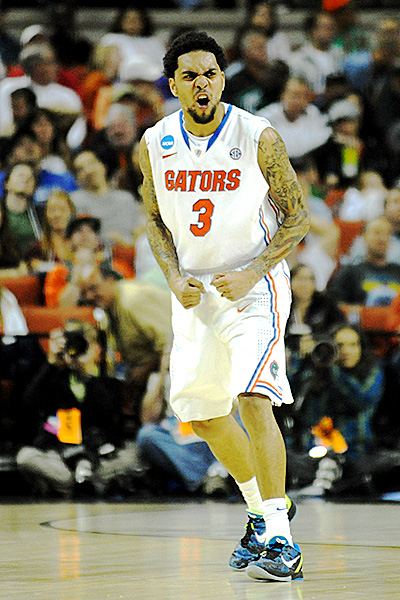Florida’s Reliance on Outside Shooting Could be a Problem
Posted by Brian Joyce on March 29th, 2013Brian Joyce is a writer for the SEC microsite and regular contributor for Rush The Court. Follow him on Twitter for more about SEC basketball at bjoyce_hoops.
Advanced metrics gurus are a special breed. They log into KenPom daily, memorize obscure stats, create new algorithms to break down play-by-play data, and probably a whole host of other geeky stat guy nuances that we don’t even know about, but above all they utilize and fully believe in advanced metrics. And if you put faith in tempo free efficiency models to justify and explain what you see on the court, chances are you’re slightly higher than the rest of the basketball world on the Florida Gators.

The effectiveness of Mike Rosario and his backcourt partners could be the key to how far Florida advances. (Brendan Maloney/USA TODAY Sports)
There are a lot of reasons to like Florida. According to KenPom, UF is the number one ranked team with the third ranked adjusted defensive efficiency unit and the fourth ranked adjusted offensive efficiency unit. Florida holds opponents to just a 42.8% effective field goal rate. We could go on, but you already know there are even more reasons to dislike the Gators’ chances of advancing. They haven’t won a game decided by single digits all year, they’ve blown several close leads, and they lack a go-to player to finish in the clutch. But when examining Florida’s play, there’s an area we can all agree on; the Gators take a lot of threes. You also don’t need advanced metrics to tell you that Billy Donovan’s squad makes a high percentage of those shots as well, making the Gators a curious case study once again for blending the observed reality with an analysis of advanced metrics.
Florida takes over 40 percent of its shots from beyond the arc. For comparison’s sake, that ranks 30th in the nation. Out of NCAA Tournament teams in 2013, only Iowa State and Illinois took a higher percentage of outside shots than Florida. But Florida makes a very high percentage too. The Gators connected on 38 percent of their threes, a mark good enough for 21st in the country. Only Indiana and Duke are more efficient tournament teams from beyond the arc. Clearly a team that takes a lot of threes and makes a high percentage of those shots will be successful, but history suggests there’s a high risk of reliance on outside shooting, and that can be a dangerous way to roll the dice.
Final Four teams that rely so heavily on three point shooting are a rarity. Since KenPom began keeping advanced statistics in 2003, only 2005 Louisville and 2011 VCU have taken over 40 percent of its shots from long range and gone to the Final Four. The 2005 Louisville squad made an incredible 40 percent of the threes it took, while the 2011 VCU team took slightly more threes than UF (41.2% of shots), but made slightly less (37%). But most Final Four teams place more emphasis on getting quality inside shots. Through play-by-play data from hoop-math, we can see that only one team from the 2012 Final Four even took more than 30 percent of its shots from outside (Louisville at 32.1%). Kentucky (which only shot 27% from outside) was the only team to shoot over 35 percent (at 38%) from deep.
Florida’s offensive game plan isn’t typical of Final Four teams of the past. Teams that live and die by the three-pointer eventually run into a situation in the NCAA Tournament where they aren’t hitting. What will the Florida Gators do when they run into a cold streak? Can they adapt? Or will they continue to rely on shots from the outside in hopes that one will fall? How the Gators react in that situation could determine their fate this weekend.












































